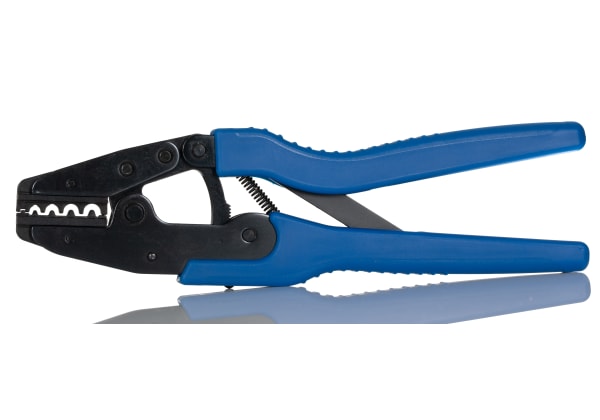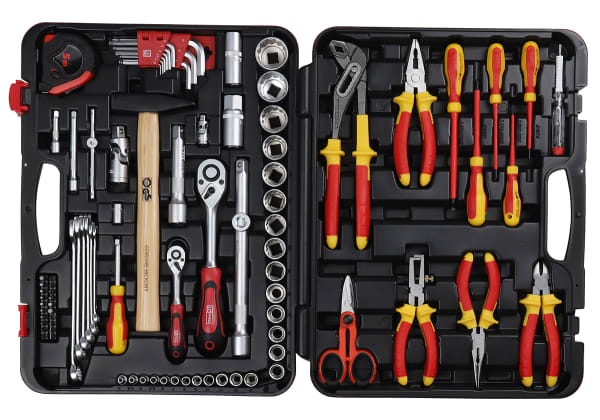- Published 13 Dec 2023
- Last Modified 12 Apr 2024
- 6 min
How to Crimp Wires
Master wire crimping with our comprehensive guide, covering techniques for crimping wires together and choosing the right wire crimping tools.

Reviewed by Stephen Bettles, Technical Support Engineer (November 2023)
Crimping wires effectively is a fundamental skill in many industries. Whether you're working in electronics, telecommunications, automotive, or any other industry that involves wiring, knowing how to crimp wires is indispensable.
Before we delve into the intricacies of wire crimping, it's important to understand the basics. Crimping wires is the process of creating a secure and reliable electrical connection by compressing a connector onto the end of a wire. This connection ensures a strong electrical and mechanical joint, making it crucial for various applications.
How to Crimp Wires Together
Crimping wires together is common in many industries. It involves joining two or more wires by crimping connectors to their ends. This section will guide you through the steps for a successful wire-to-wire crimp, ensuring a reliable connection.
- Prepare the Wires: Strip the insulation from the ends of the wires to expose a suitable length of conductor. Refer to connector literature for exact dimensions
- Select the Correct Connector: Choose the appropriate crimp connector for your wires. Connectors come in many sizes and styles, so ensure you pick one that matches the cross-sectional area of your wire
- Insert the Wires: Place the stripped wire ends into the connector, making sure each wire is fully seated
- Crimp the Connector: Using a wire crimping tool, compress the connector to secure the wires. Ensure the tool is one specified by the connector manufacturer
- Inspect the Crimp: After crimping, inspect the connection to ensure there are no exposed wires or loose connectors. A well-executed crimp should be both electrically and mechanically sound. Perform a pull test if required
How to Use Wire Crimping Tools
For more information about how to use wire crimping tools, check out our dedicated crimp tools guide. The guide covers all the essentials you need to know about these tools. This includes their main uses, connectors and accessories, and the different types and categories of crimp tools.
Reasons to Use the Correct Crimping Tool
While it's essential to know how to crimp wires, it's equally important to understand that using the right tools for the job is the most effective practice.
Crimping wires with the appropriate tool ensures a consistent, reliable, and safe connection. These tools are specifically designed to exert the correct amount of pressure on the wire and terminal. This results in a tight connection that withstands vibrations, stress, and environmental factors.
Here are some reasons to always use a crimp tool:
- Reliability: Crimp tools are engineered to create a uniform, tight connection by applying precise pressure, ensuring that the wire and terminal are held together securely. This level of consistency is difficult to achieve when crimping by hand
- Safety: Crimped connections are less likely to come loose, reducing the risk of short circuits, electrical fires, or other safety hazards. A proper crimp connection prevents wires from accidentally separating or being exposed to the elements
- Longevity: Crimped connections are built to last. When crimped with the right tool, wires remain securely attached even in high-stress environments, without corrosion or degradation
- Standards Compliance: Many industries and applications have specific standards and regulations that require approved crimping tools. Using the right tool ensures compliance with these standards, which is often essential for safety and legal reasons
- Ease of Use: Crimping tools are designed to be user-friendly and often come with adjustable settings for different wire sizes and terminal types. This makes the crimping process more efficient and precise
Therefore, it is highly advisable to use a dedicated crimp tool for all your electrical and wiring needs. Your safety and the integrity of your electrical connections are well worth the investment in a quality crimp tool.
Wire Crimping Safety Considerations
Crimping wires together is a widespread practice in many industries, but it's not only about creating a reliable connection; safety is paramount. Working with electrical connections demands careful attention to detail to prevent accidents or damage.
Here are some key safety considerations when crimping wires together:
- Disconnect the Power: Before working on electrical connections, always ensure that the power source is disconnected. Turn off the relevant circuit breaker or unplug any devices to eliminate electric shock risk
- Personal Protective Equipment (PPE): Wear appropriate PPE, including insulated gloves and safety goggles. This protective gear will safeguard you from electrical hazards and flying debris during crimping
- Inspect Wires for Damage: Before crimping, check for any signs of damage, such as exposed conductors, cuts, or fraying. Damaged wires should be replaced rather than crimped
- Proper Wire Size and Connector: Always match the wire size to the correct connector size. Using connectors that are too large or too small for the wire can result in poor connections and safety hazards
- Positioning: Ensure that wires are properly inserted into the connector and secured firmly. Loose connections can lead to heat build-up and an increased risk of electrical fires
- Crimping Tool Maintenance: Regularly inspect and maintain your crimping tool. Make sure it is in proper working condition, and keep it clean to prevent mishaps during use
- Grounding: In some applications, you may need to connect wires to ground. Be aware of the specific requirements for grounding to ensure proper safety measures
- Work in a Dry Environment: Avoid crimping wires in wet or damp conditions and keep your work area dry. Water and electricity do not mix well, and moisture can lead to short circuits and other hazards
- Double-Check Connections: After crimping, double-check your connections to ensure they are secure and free from exposed wires. This step is crucial to preventing electrical faults or short circuits
By incorporating these safety measures into your wire crimping process, you can create reliable connections, reduce the risk of accidents, and maintain a safe working environment. Always remember that safety should be a top priority when dealing with electrical connections.
Types of Crimping Tools
Investing in high-quality wire crimping tools is essential for professionals who frequently work with wires. The right tools make the job easier, more efficient, and ensure reliable connections. Here are some of the different types of crimping tool types available:
- Ratcheting Crimpers: These tools offer precise control and uniform crimps. They are available in assorted sizes to accommodate different wire and connector types
- Hydraulic Crimpers: Hydraulic crimping tools provide immense pressure for heavy-duty applications and larger wire sizes. They are commonly used in industrial settings and help prevent user fatigue
- Battery-Powered Crimpers: Battery-operated crimping tools are ideal for professionals who need mobility and speed in their work. They are especially useful for fieldwork
- Manual Crimping Tools: Manual crimpers come in various shapes and sizes, including hand-held pliers, and are suitable for small-scale projects and occasional use. They are usually more cost-effective
Summary
Knowing how to crimp wires effectively is a skill that can't be overstated. Whether you're connecting wires for electrical systems, telecommunications, or automotive applications, mastering the art of wire crimping is crucial for creating secure and reliable connections. So, make sure that you equip yourself with the knowledge and tools needed to excel in your industry through wire crimping.



